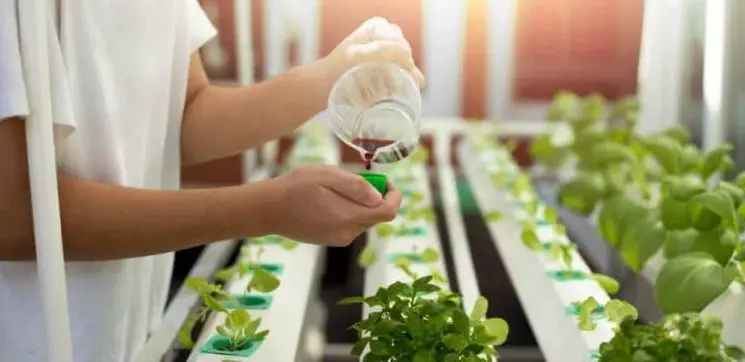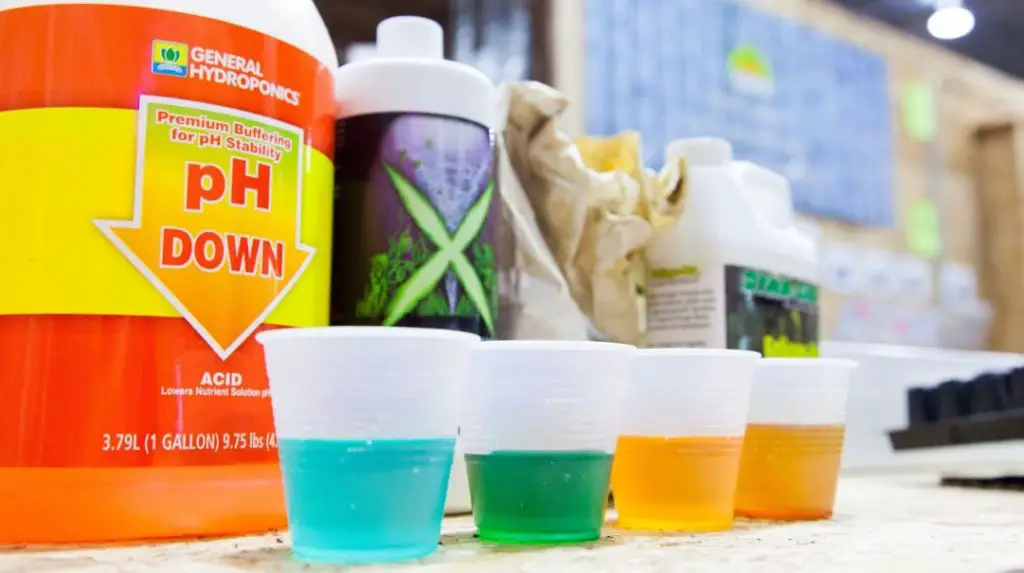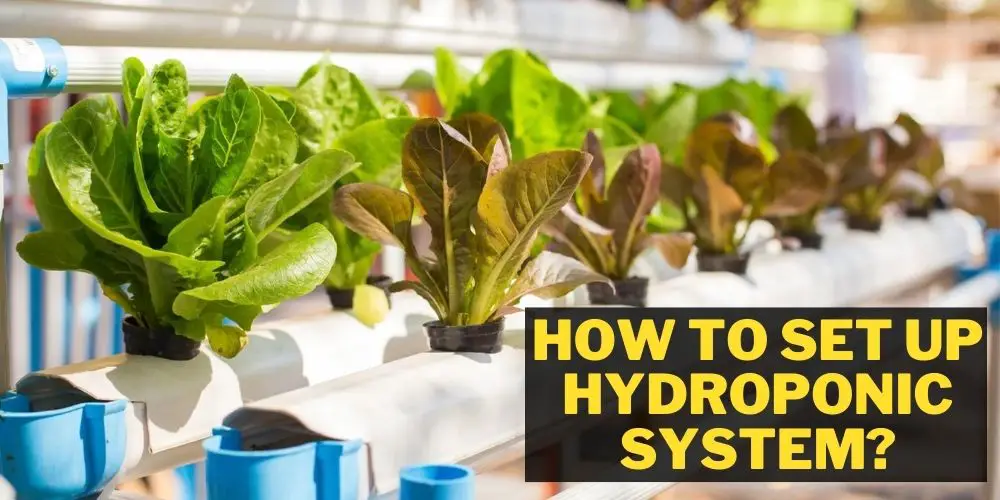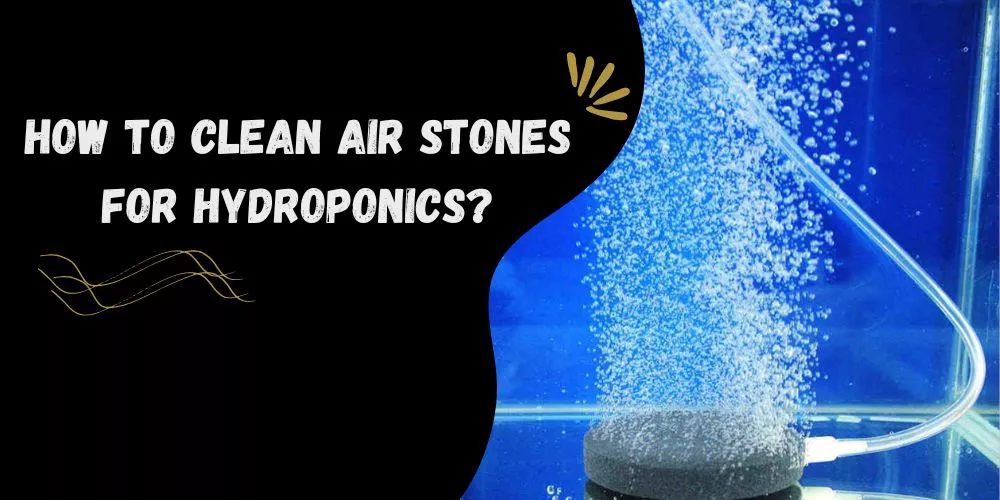Whether you’re using a hydroponic system for growing plants, managing and storing nutrients can be tricky. A hydroponic system has an even greater need as it doesn’t have the luxury of natural nutrients that you get from planting in soil. Composts and manures are common additives within traditional growing methods.
Most hydroponic plant boosters and nutrients have been carefully engineered and backed by extensive research. They are also designed to offer supreme longevity. A few factors can affect the shelf life of nutrients, including storing and using within excess heat conditions, increased moisture, and exposure to too much air.

In general, nutrients should be stored in a cool, dark, and of course, dry area and correctly sealed. It’s also ideal for keeping them in the 77 degrees Fahrenheit (25 degrees Celsius) temperature range, and this will ensure they are ready to use when the time arises.
Table of Contents
Can hydroponic nutrients go bad/Expire?
Nutrients for hydroponic are long-lasting and they do not god bad if stored correctly as I mentioned above. For the serious grower, nutrient packs are often purchased in bulk, making it even more necessary to ensure that larger amounts of the stuff cannot go bad. Imagine going out and buying a few growth cycles worth it only to find the quality diluted due to poor storage. It’s not an ideal situation to be in, that’s for sure!
The mid to top-priced brands and ranges are known to last years without losing quality, and most of them don’t even come with an expiry date which proves their longevity.
The ideal storage environment for your hydroponic nutrients for it to not go bad:
- Water or other moist areas
- Chemicals such as but not limited to pesticides (anything that could potentially leach in and spoil)
- Extreme temperatures on both sides of the spectrum (heat and chill) Consistent temperatures of around 77 degrees Fahrenheit (25 degrees Celsius).
- Excess light and air
- Preferably up off the floor, but if that isn’t possible, then a floor that doesn’t pool liquids or allows any to seep through.
Factors Affecting the Health of Hydroponic Nutrients
3 main factors contribute to the health and longevity of hydroponic nutrients, and these aspects can spoil them if not counter-planned or corrected as soon as discovered. The factors are heat, moisture, and air exposure, and let’s look at what actual effect they can have.

Heat
The optimal temperature of a hydroponic solution should be within the 60° F to 75° F range (15.5°C to 24°C). This temperature is ideal for storage as well as usage. Some of the more leafy plants like lettuce and strawberries enjoy the lower end of that range.
On the other hand, some more heavy crops, such as cucumbers and tomatoes, thrive under the higher temperatures.
Too Cool
If the nutrient solution is colder than the optimum temperature range, it can have a detrimental effect on their dissolved form. Furthermore, it can skew their physiological attributes. As a result, this can ultimately reduce the growth rate.
These issues usually occur in colder climates or depending on how the hydroponic system has been constructed. For example, the reservoir tank could be buried underground, or the piping may not be sufficiently insulated to counteract the setup environment.
Too Warm
One of the major issues with having a solution reach temperatures above the optimum range is that the oxygen levels tend to decrease. As a result, the solution can evaporate, which leaves a higher concentration of nutrients in the system. When this is the case, it can suffer from negative conditions.
These can include wilting, fungi and root-borne insects, fruit abortion, plant heat stress, and a build-up of possibly harmful bacteria, to name a few. These conditions occur more in warmer climates and due to the system’s construction. Some possible solutions can involve proper insulation of the tanks, installing external shading, adding extra fans, etc.
Note that even dry nutrients can become less effective once they heat up. On a final remark, nutrients like ammonium nitrate and potassium nitrate have been known to explode if it is exposed to direct sunlight for long time, so keep that in mind when storing!
Moisture
When talking about moisture affecting the health of hydroponic solution, the finger is quite often pointed toward humidity. The optimal humidity range for most plants is between 45% and 85%. Most of these crop types are more suited to the higher range at around the 75% to 85% mark. Conditions considered too humid for a hydroponic system can easily produce excessive mold that is tough to stay on top of once it establishes itself.
Additionally, pests also thrive in the stagnant, humid air. As a result, the nutrients can lose their potency. Moreover, if it’s too humid or not humid enough, the flow of transpiring nutrients can slow down or even stop completely. When planning the structure of a hydroponic system, adequate ventilation should be of top priority.
This factor alone will assist with temperature and humidity control, resulting in the reinstating of fresh air. In addition, some well-placed fans can aid in the onset of patchy humidity. Moisture, as a stand-alone problem, can cause the issue of clumping and caking of any dry nutrients. This will cause degradation of the nutrients.
If you suspect humidity problem, the first step is to check humidity level. Here’s a video that can help:
Air Exposure
Air exposure is a known factor to cause negative effects on the health of hydroponic nutrients. This is because the nutrient solution assists with supplying oxygen to the roots to facilitate artificial respiration. Therefore, if the solution is insufficiently aerated, the roots will wilt and root.
As a result, given that the roots are where the plant’s growth comes from, the rest of the plant will also die. Furthermore, if too much oxygen is combined with the nutrient solution, there is a greater risk of stunted growth in the root system.
Under those circumstances, both too little or too much air exposure should be hastily corrected if the problem arises. Air exposure is also a prime cause of caking with dry nutrients. On the other hand, liquid nutrients will dissipate if exposed to air for longer periods.
So, if you are wondering about can hydroponic nutrients go bad, you should keep these factors in mind.
Why Shake Well Before Using Hydroponic Nutrients?
When it comes to mixing a hydroponic solution, it isn’t just a matter of throwing all the nutrients together in a container and hoping for the best. There is a fine art involved and for a good reason. Yes, there will be some shaking, but a specific order must be followed before we get to that point.
Before we get to the shaking, it’s important to quickly cover a couple of commonly used terms for anyone unsure what they mean. These terms are used throughout the entirety of a hydroponic process, so they are worthwhile completely understanding.
pH (Potential Hydrogen)
This is a number to indicate where the solution sits within a scale that measures alkalinity and acidity. 1 being most acidic and 14 being most alkaline.
- 1-6 (Acidic)
- 7 (Neutral)
- 7-14 (Alkaline)
EC (Electrical Conductivity)
This is the measurement used to determine the strength of electrical conductivity within your nutrient solution. Now that we understand these terms, we get into the mixing and shaking.
Hydroponic nutrients generally come in a handy, well labeled, color-coded, 3 part liquid form. The 3 parts usually consist of ‘grow,’ ‘micro,’ and ‘bloom’ Each part has its specific role. They offer a deliberate amount of micro and macronutrients to assist with optimum development for plants during each stage of their growth cycle.
Micro Nutrients
Include calcium, magnesium, sulfur, boron, manganese, copper, iron, zinc, and molybdenum. (offered by micro part)
Macro Nutrients
Include nitrogen, potassium, and phosphorous (offered by grow/bloom parts) When mixing the hydroponic solution, it’s ideal for shaking all nutrients well before mixing them in. Shaking them removes any solid precipitates formed on the bottom of the containers.
Generally speaking, this is a storage issue that could have built up over time, and it’s more often than not that calcium causes this issue. Once a good shaking has occurred, add the solutions separately to the reservoir. Make sure to give any measuring utensils a really good rinse between each solution, so each one enters clean.
Best Hydroponic Nutrient Brands
Hydroponics is fast becoming a common hobby even for traditional growers. It’s generally more precise, cost-effective, and saves a ton of space and time compared to the old-school methods. There has been a lot of noise of late regarding the best nutrients and their respective brands amongst the hydro fraternity.
Here are a few brands and their top products that we have tried and tested ourselves based on use cases and various reviews.
General Hydroponics Flora Grow, Bloom, Micro Combo Fertilizer set, 1 Gallon (Pack of 3)
It includes FloraMicro, FloraBloom, and FloraGro. Each part of the series helps with specific plant growth stages.
- FloraMicro: Contains a range of essential micronutrients for optimal growth. These include Nitrogen and Calcium.
- FloraBloom: This contains the perfect blend of nutrients required for the flowering and fruiting stage. These include Phosphorus, Potassium, Magnesium, and Sulfur.
- FloraGro: Contains extra nutrients that assist with structural and foliar growth. These include Nitrogen and Potassium.
Other great products from the General Hydroponic range are the following:
- General Hydroponics Rapidstart Rooting Enhancer (This stuff is a good Kickstarter that promotes strong, healthy root development.)
- 1 Gallon General Hydroponics pH Up Liquid Premium Buffering For pH Stability (This is one of the best pHs Up formulas in the business.)
- 1 Gallon General Hydroponics pH Down Liquid Premium Buffering For Stability (On the other end of the scale, this formula helps lower pH levels.)
Fox Farm
Then we have FoxFarm. They have been testing and engineering the finest soil mixes, fertilizers, and micro-brewed liquid plant foods since 1984. They are considered to be up there with General Hydroponics as far as quality is concerned. Some of their top products include another high-quality trio series:
3/32-Ounce Bottles – FoxFarm FX14050 Big Bloom, Grow Big & Tiger Bloom Liquid Fertilizer Nutrient Trio Hydro-Formula
This one comes with the fertilizers required to assist with the growth of mature, late-season flowers and fruit.
- Grow Big Hydro: Improves the quality of green growth.
- Tiger Bloom: Phase 2 which promotes bud set or flowering
- Big Bloom: This can be used as a general fertilizer throughout all growing cycles. Its purpose is to help fortify root systems and assist with the nutrient cycling process.
Other great products from the Fox Farm range are the following:
- Soluble Nutrient Trio: Open Sesame, Cha Ching & Beastie Bloomz (Pack of 3-6 oz Jars) + Twin Canaries Chart
- 1.5 cubic ft – FoxFarm Ocean Forest Potting Soil
AeroGarden Liquid Nutrients (1 Liter)
To round off the leading brands in the hydroponics industry, we have Aero Garden. These guys specialize in seed kits, grow lights, harvesting tools, and liquid nutrients. Some of their top products include:
This is a One-part nutrient liquid optimal for seedlings, vegetative growth, and flowering, and it suits both indoor and outdoor plants.
Another top product from Aero Garden:
EZ-gro Liquid Plant Food for Aerogardens (1 PT) | Hydroponic Liquid Fertilizer for Smart Garden
These are just a small snippet of what is on the market. We should give an honorable mention to Botanicare and HGV, who also have some kick-ass products worth testing out. Don’t forget to keep checking for a more detailed block of posts to help break down the amount of information required to fully grasp this nutrient concept.
How to dispose of hydroponic nutrients Correctly?
As we touched on earlier, hydroponic nutrients are quite resilient. They last quite some time, and it takes some pretty harsh conditions to spoil them. If you want to dispose of them for whatever reason, it’s worth noting that they can be reused. It’s as simple as diluting any remaining nutrients in your reservoir.
Just mix the leftover wastewater with an equivalent amount of normal tap water. Empty the reservoir into something that can be used to transport the water to indoor and/or outdoor plants. E.g., a watering can or bucket.
Any remains of the wastewater can be carefully poured down a drain. It’s not recommended to do this last step so often to look after the environment. Try to use it on plants as much as possible.
As far as the containers are concerned, it’s recommended to follow a few simple steps to adhere to environmental protocols.
- Any container with a “DANGER-CORROSIVE” label. Should avoid being emptied down a drain.
- Using some paper towels or old newspapers, try to remove any excess moisture.
- Double bag the empty container. Make sure each bag is tightly sealed.
- Mark the bag with “Danger – Not for Recycling.”
- Dispose of the bag in the normal garbage bin if labeled with Danger. If not, dispose of the bag in the appropriate recycling bin.
Here are some beginners hydroponic guide: Do LED Lights Work For Hydroponics? – How Often To Change Hydroponic Water? – Do Hydroponics Need Sunlight? – Does Pot Size Matter in Hydroponics?
Frequently Asked Questions (FAQs)
1. How long should mixed hydroponic nutrients be used?
As we have covered during this post, hydroponic nutrients have an extremely long shelf life. That shelf life is only valid while still in their original containers. Once the nutrients have been mixed, their longevity diminishes.
This doesn’t apply to all types but as a rule of thumb, try to only mix what you will use under 2 weeks. A great tip for when using this mixture is to Check the pH levels of the solution every time. This will ensure the pH won’t have seesawed out of its optimal range.
2. Should we change hydroponic nutrients frequently?
The most reliable way to know when to change out your hydroponics nutrient solution is when the volume of any added top-off water is equal to the tank’s total volume.
This method will see that the solution receives a complete changeover and prevents the build-up of excess nutrients, bacteria, and fungi. If the water doesn’t build up as fast, it’s a good idea to complete this process every 2 weeks.
3. Can I use liquid fertilizer in hydroponics?
Liquid fertilizers are the best type for a hydroponic system, and they are also the easiest to measure and apply. Furthermore, plants don’t even mind if the solution is organic or man-made as long as they get the right nutrients and the right amount of them.
Conclusion
if you are asking can hydroponic nutrients go bad, I must say storing your nutrients in the right conditions will provide extra shelf life. Dark and dry areas in a completely sealed container are optimal for this to be possible. When it comes to disposal, it’s important to note that the solution can be repurposed, saving some money in the long run. We hope that this article has been helpful and we can continue to increase your knowledge and confidence in the garden!






